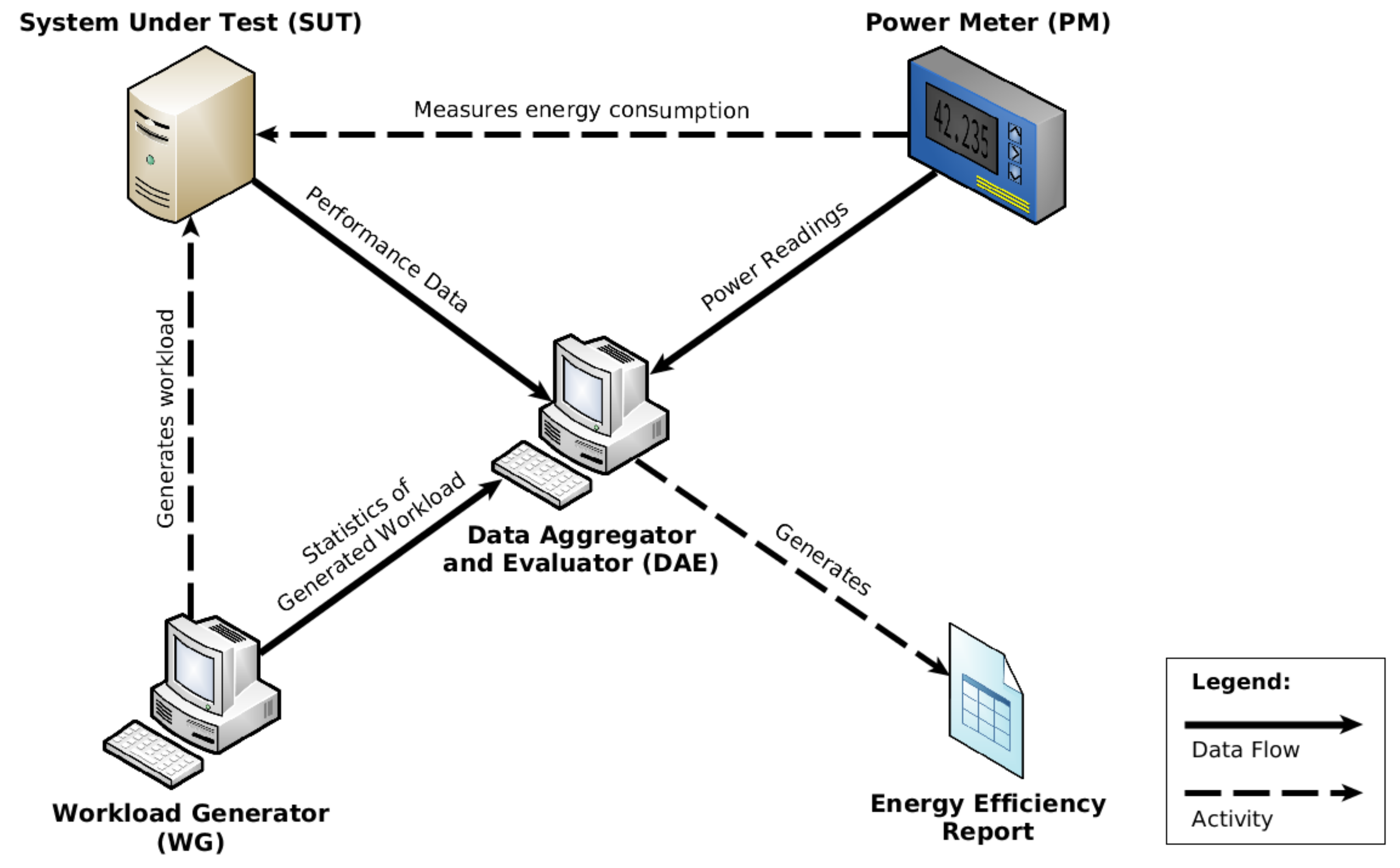An Analysis of the Energy Consumption Behavior of Scaled, Containerized Web Apps
Abstract
:1. Introduction
2. Experiment Backgrounds, Prospects, and Related Work
3. Measurement Setup and Results
3.1. Preliminary Experiment
3.2. Measuring Environment
3.3. Results
3.3.1. Comparison between Docker and Rocket
3.3.2. Comparison of One Container under Load to Several Containers
4. Analysis of the Results
5. Conclusions and Future Work
Author Contributions
Funding
Conflicts of Interest
References
- Deep Borah, A.; Mucharary, D.; Singh, S.; Borah, J. Power saving strategies in green cloud computing systems. Int. J. Grid Distrib. Comput. 2015, 8, 299–306. [Google Scholar] [CrossRef]
- What Is Docker. Available online: https://www.docker.com/what-docker (accessed on 8 May 2018).
- About Docker. Available online: https://www.docker.com/company (accessed on 8 May 2018).
- Docker Overview. Available online: https://docs.docker.com/engine/docker-overview/#what-can-i-use-docker-for (accessed on 8 May 2018).
- Docker Usage Statistics: Increased Adoption by Enterprises and for Production Use. Available online: https://www.coscale.com/blog/docker-usage-statistics-increased-adoption-by-enterprises-and-for-production-use (accessed on 3 July 2018).
- Penzenstadler, B.; Bauer, V.; Calero, C.; Franch, X. Sustainability in software engineering: A systematic literature review. In Proceedings of the 16th International Conference on Evaluation & Assessment in Software Engineering (EASE 2012), Ciudad Real, Spain, 14–15 May 2012; pp. 32–41. [Google Scholar] [CrossRef]
- Hilty, L.M.; Aebischer, B. ICT for Sustainability: An Emerging Research Field. In ICT Innovations for Sustainability: Advances in Intelligent Systems and Computing; Hilty, L.M., Aebsicher, B., Eds.; Springer: Basel, Switzerland, 2015; pp. 3–36. [Google Scholar]
- Naumann, S.; Dick, M.; Kern, E.; Johann, T. The GREENSOFT model: A reference model for green and sustainable software and its engineering. Sustain. Comput. Inform. Syst. 2011, 1, 294–304. [Google Scholar] [CrossRef]
- Green Software Engineering Criteria Catalog. Available online: http://green-software-engineering.de/kriterienkatalog-v01/einleitung.html (accessed on 8 May 2018).
- Andrae, Anders (Huawei). Total Consumer Power Consumption Forecast. 2017. Available online: https://www.researchgate.net/publication/320225452_Total_Consumer_Power_Consumption_Forecast (accessed on 3 July 2018).
- Andrae, A.S.G.; Edler, T. On global electricity usage of communication technology: Trends to 2030. Challenges 2015, 6, 117–157. [Google Scholar] [CrossRef]
- Gartner Infineon. Worldwide Server Shipments from 2010 to 2017 (in Million Units). Available online: https://www.statista.com/statistics/219596/worldwide-server-shipments-by-vendor/ (accessed on 4 July 2018).
- Stack Overflow Insight Trends. Available online: https://insights.stackoverflow.com/trends?tags=containers%2Cdocker (accessed on 4 July 2018).
- Kern, E.; Hilty, L.M.; Guldner, A.; Maksimov, Y.V.; Filler, A.; Gröger, J.; Naumann, S. Sustainable software products-Towards assessment criteria for resource and energy efficiency. Future Gener. Comput. Syst. 2018, 86, 199–210. [Google Scholar] [CrossRef]
- Tadesse, S.; Chiasserini, C.-F.; Malandrino, F. Energy consumption measurements in docker. In Proceedings of the IEEE 41st Annual Computer Software and Applications Conference, Turin, Italy, 4–8 July 2017; pp. 272–273. [Google Scholar]
- Santos, E.; McLean, C.; Solinas, C.; Hindle, A. How does Docker affect energy consumption? Evaluating workloads in and out of Docker containers. arXiv, 2017; arXiv:1705.01176. [Google Scholar]
- Kang, D.K.; Choi, G.B.; Kim, S.H.; Hwang, I.S.; Youn, C.H. Workload-aware resource management for energy efficient heterogeneous Docker containers. In Proceedings of the 2016 IEEE Region 10 Conference (TENCON), Singapore, 22–25 November 2016; pp. 2428–2431. [Google Scholar] [CrossRef]
- Piraghaj, S.F.; Dastjerdi, A.V.; Calheiros, R.N.; Buyya, R. A framework and algorithm for energy efficient container consolidation in cloud data centers. In Proceedings of the 2015 IEEE International Conference on Data Science and Data Intensive Systems, Sydney, NSW, Australia, 11–13 December 2015; pp. 368–375. [Google Scholar] [CrossRef]
- CoreOS Rocket. Available online: https://coreos.com/rkt/docs/latest/rkt-vs-other-projects.html#process-model (accessed on 8 May 2018).
- Dirlewanger, W. Measurement and Rating of Computer Systems Performance and of Software Efficiency: An Introduction to the ISO/IEC 14756 Method and a Guide to Its Application; Kassel University Press: Kassel, Germany, 2006. [Google Scholar]
- Figures Regarding Sustainable Software Engineering. Available online: http://green-software-engineering.de/en/downloads.html (accessed on 8 May 2018).
- Siege Home. Available online: https://www.joedog.org/siege-home/ (accessed on 8 May 2018).
- Gude Expert Power Control 1202. Available online: https://www.gude.info/power-distribution/switched-metered-pdu/expert-power-control-1202-serie.html (accessed on 8 May 2018).
- Udoo x86. Available online: https://www.udoo.org/udoo-x86/ (accessed on 8 May 2018).
- Nickoloff, J. Docker in Action pp. 44-48: 3.2 Finding and Installing Software; Manning: Shelter Island, NY, USA, 2016; ISBN 9781633430235. [Google Scholar]
- DeJonghe, D. Compelte NGINX Cookbook; O’Reilly: Sebastopol, CA, USA, 2017; ISBN 9781491968656. [Google Scholar]
- Replication Package and Raw Data. Available online: https://gitlab.umwelt-campus.de/skreten/Docker_Energy_Measurements (accessed on 1 August 2018).
- Horizontal Pod Autoscaler. Available online: https://kubernetes.io/docs/tasks/run-application/horizontal-pod-autoscale/ (accessed on 8 May 2018).
- Fan, X.; Weber, W.-D.; Barroso, L.A. Power provisioning for a warehouse-sized computer. In SIGARCH Computer Architecture News; ACM: New York, NY, USA, 2007; Volume 35, pp. 13–23. [Google Scholar] [CrossRef]










| Rocket (rkt) | Process Description | Docker | Process Description | |
|---|---|---|---|---|
| 1 | systemd | System daemon for starting, monitoring, and closing processes | systemd | System daemon for starting, monitoring, and closing processes |
| 2 | rkt run container | Processes the client command, talks to init systems such as systemd | docker run container | Processes the client command, talks to Docker daemon API and containerd |
| 3 | application | Process of the application | docker engine | Process of the docker containerization technology |
| 4 | containerd | Container runtime system with open standard of the Open Container Initiative | ||
| 5 | run C | Container runtime system, used to interact with the host system | ||
| 6 | application | Process of the application |
© 2018 by the authors. Licensee MDPI, Basel, Switzerland. This article is an open access article distributed under the terms and conditions of the Creative Commons Attribution (CC BY) license (http://creativecommons.org/licenses/by/4.0/).
Share and Cite
Kreten, S.; Guldner, A.; Naumann, S. An Analysis of the Energy Consumption Behavior of Scaled, Containerized Web Apps. Sustainability 2018, 10, 2710. https://doi.org/10.3390/su10082710
Kreten S, Guldner A, Naumann S. An Analysis of the Energy Consumption Behavior of Scaled, Containerized Web Apps. Sustainability. 2018; 10(8):2710. https://doi.org/10.3390/su10082710
Chicago/Turabian StyleKreten, Sandro, Achim Guldner, and Stefan Naumann. 2018. "An Analysis of the Energy Consumption Behavior of Scaled, Containerized Web Apps" Sustainability 10, no. 8: 2710. https://doi.org/10.3390/su10082710
APA StyleKreten, S., Guldner, A., & Naumann, S. (2018). An Analysis of the Energy Consumption Behavior of Scaled, Containerized Web Apps. Sustainability, 10(8), 2710. https://doi.org/10.3390/su10082710





